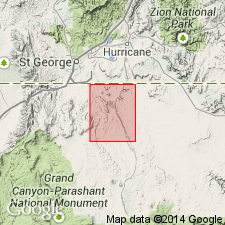
- Usage in publication:
-
- Black Rock Canyon Basalt*
- Modifications:
-
- Named
- Mapped 1:31,680
- Dominant lithology:
-
- Basalt
- AAPG geologic province:
-
- Plateau sedimentary province
Summary:
Named for occurrence at Black Rock Canyon of Hurricane Wash which is designated as its type area and is located in T41N, R10W, northern Mohave Co, AZ, Plateau sedimentary province. Mapped in type area within northeast-central part of map area. Consists of one or two flows of dark-gray, finely crystalline basalt with aphanitic groundmass and sparse olive phenocrysts. Source of flows not found but likely near summit of bench mark on map labeled Butte (el. 5,104 ft) west of Black Rock Canyon. Flow extruded onto Shinarump and Petrified Forest Members of Chinle Formation and on upper red member of Moenkopi Formation. Basalt flowed east and down east-dipping Triassic strata toward Hurricane Cliffs then north down Hurricane Wash; solidified-basalt blocks and mudstone of Petrified Forest slid east into Hurricane Wash. Flows are up to about 8 m thick. About 1 m.y. older than newly named Seegmiller Mountain Basalt; about same age as basalt flows at Black Rock Mountain and Wolf Hole Mountain (3.7 and 3.1 Ma respectively), located about 10 km west of map area. K-Ar age is 3.5 +/-0.6 Ma (Pliocene).
Source: GNU records (USGS DDS-6; Denver GNULEX).
For more information, please contact Nancy Stamm, Geologic Names Committee Secretary.
Asterisk (*) indicates published by U.S. Geological Survey authors.
"No current usage" (†) implies that a name has been abandoned or has fallen into disuse. Former usage and, if known, replacement name given in parentheses ( ).
Slash (/) indicates name conflicts with nomenclatural guidelines (CSN, 1933; ACSN, 1961, 1970; NACSN, 1983, 2005, 2021). May be explained within brackets ([ ]).

